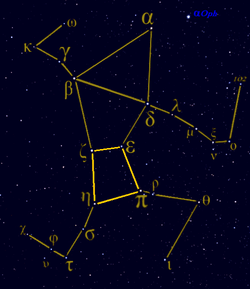Tau Herculis
 Historical view of the Hercules constellation showing Rukbalgethi Shemali (τ Her) as the "northern knee" | |
| Observation data Epoch J2000 Equinox J2000 | |
|---|---|
| Constellation | Hercules |
| Right ascension | 16h 19m 44.4368s[1] |
| Declination | 46° 18′ 48.119″[1] |
| Apparent magnitude (V) | 3.89[1] |
| Characteristics | |
| Spectral type | B5 IV[1] |
| U−B color index | -0.57[2] |
| B−V color index | -0.155[2] |
| Astrometry | |
| Radial velocity (Rv) | -13.8[1] km/s |
| Proper motion (μ) | RA: -13.15[1] mas/yr Dec.: 39.31[1] mas/yr |
| Parallax (π) | 10.37 ± 0.53[3] mas |
| Distance | 310 ± 20 ly (96 ± 5 pc) |
| Absolute magnitude (MV) | -1.03 |
| Details | |
| Mass | 4.9[4] M☉ |
| Radius | 3.55 ± 0.19[5] R☉ |
| Luminosity | 700[4] L☉ |
| Surface gravity (log g) | 4.02 ± 0.05[5] cgs |
| Temperature | 15,615 ± 301[5] K |
| Metallicity [Fe/H] | 0.15[6] dex |
| Rotational velocity (v sin i) | 46[7] km/s |
| Age | 1[4] Gyr |
| Other designations | |
| Database references | |
| SIMBAD | data |
Coordinates: ![]() 16h 19m 44.437s, +46° 18′ 48.12″
16h 19m 44.437s, +46° 18′ 48.12″
Tau Herculis (τ Her, τ Herculis) is a fourth-magnitude star in the constellation Hercules. Its traditional name Rukbalgethi Shemali, though seldom used today in scientific journals, means the "northern knee". It is a blue subgiant star, seven hundred times more luminous than the Sun.
Properties
Tau Herculis is a blue subgiant star with stellar classification B5IV. Its mass is 4.9 times solar.[4] Though its apparent magnitude is only 3.89, like all B-class stars, it is very luminous boasting a total bolometric luminosity that is 700 times solar.[4] Hipparcos estimated its distance at roughly 96 parsecs from Earth, or 310 ± 20 light years away.
Etymology
Its traditional name Rukbalgethi Shemali is of Arabic origin and shares certain etymological characteristics with the stars Ruchbah and Zubeneschamali signifying Hercules' "northern knee".[8] The star was the north pole star around the year 7400 BC, a phenomenon which is expected to reoccur in the year 18,400 due to precession.[4]
In Chinese, 七公 (Qī Gōng), meaning Seven Excellencies, refers to an asterism consisting of τ Herculis, 42 Herculis, φ Herculis, χ Herculis, ν1 Boötis, μ1 Boötis and δ Boötis.[9] Consequently, τ Herculis itself is known as 七公二 (Qī Gōng èr, English: the Second Star of Seven Excellencies.)[10]
See also
- Lists of stars in the constellation Hercules
- Class B Stars
- Subgiant star
References
- 1 2 3 4 5 6 7 SIMBAD query result: tau Her -- Pulsating variable Star, Centre de Données astronomiques de Strasbourg, retrieved 2010-06-10
- 1 2 Mermilliod, J.-C. (1986), Compilation of Eggen's UBV data, transformed to UBV (unpublished) (PDF), SIMBAD, Bibcode:1986EgUBV........0M
- ↑ Perryman, M. A. C.; et al. (1997), "The Hipparcos Catalogue", Astronomy & Astrophysics, 323: L49–L52, Bibcode:1997A&A...323L..49P
- 1 2 3 4 5 6 Kaler, James B., "TAU HER (Tau Herculis)", stars, University of Illinois, retrieved 2010-06-10
- 1 2 3 Fitzpatrick, E. L.; Massa, D. (March 2005), "Determining the Physical Properties of the B Stars. II. Calibration of Synthetic Photometry", The Astronomical Journal, 129 (3): 1642–1662, arXiv:astro-ph/0412542
 , Bibcode:2005AJ....129.1642F, doi:10.1086/427855
, Bibcode:2005AJ....129.1642F, doi:10.1086/427855 - ↑ Smith, K. C.; Dworetsky, M. M. (1993), "Elemental Abundances in Normal Late B-Stars and Hgmn-Stars from Co-Added IUE Spectra - Part One - Iron Peak Elements", Astronomy and Astrophysics, 274 (2): 335, Bibcode:1993A&A...274..335S
- ↑ Royer, F.; et al. (2002), "Rotational velocities of A-type stars in the northern hemisphere. II. Measurement of v sin i in the northern hemisphere", Astronomy and Astrophysics, 393 (3): 897–911, arXiv:astro-ph/0205255
 , Bibcode:2002A&A...393..897R, doi:10.1051/0004-6361:20020943
, Bibcode:2002A&A...393..897R, doi:10.1051/0004-6361:20020943 - ↑ Kurt Vonnegut. "Constellations: Hercules 'the Strongman'". The BBC (British Broadcasting Corporation). Retrieved 2010-11-14.
- ↑ (Chinese) 中國星座神話, written by 陳久金. Published by 台灣書房出版有限公司, 2005, ISBN 978-986-7332-25-7.
- ↑ (Chinese) AEEA (Activities of Exhibition and Education in Astronomy) 天文教育資訊網 2006 年 6 月 26 日